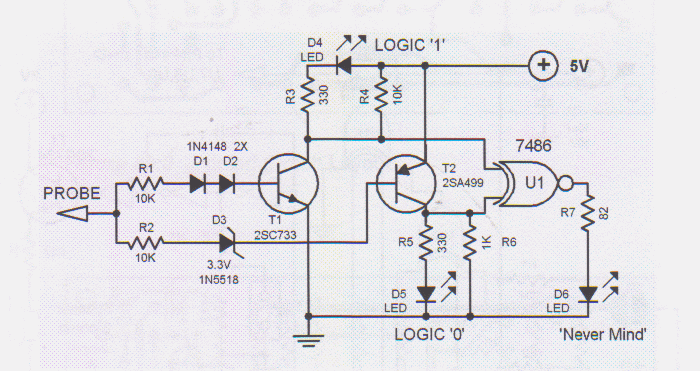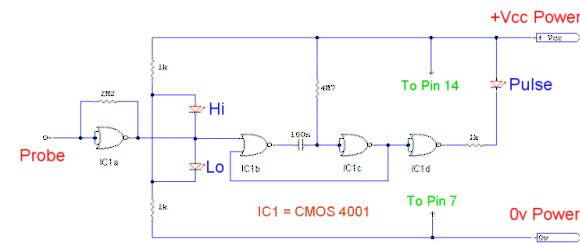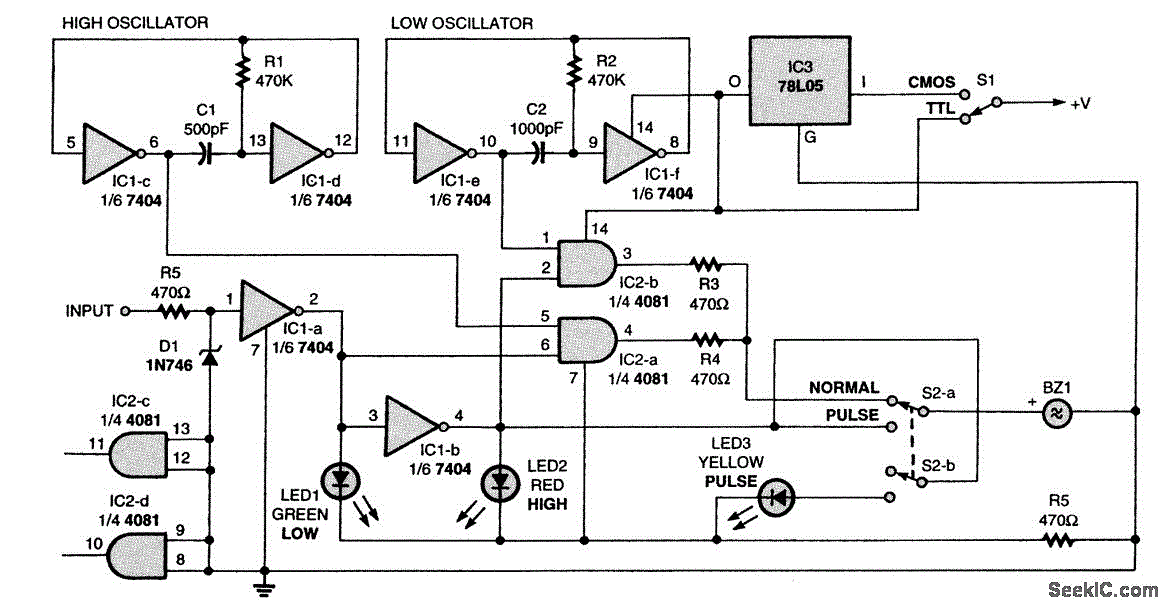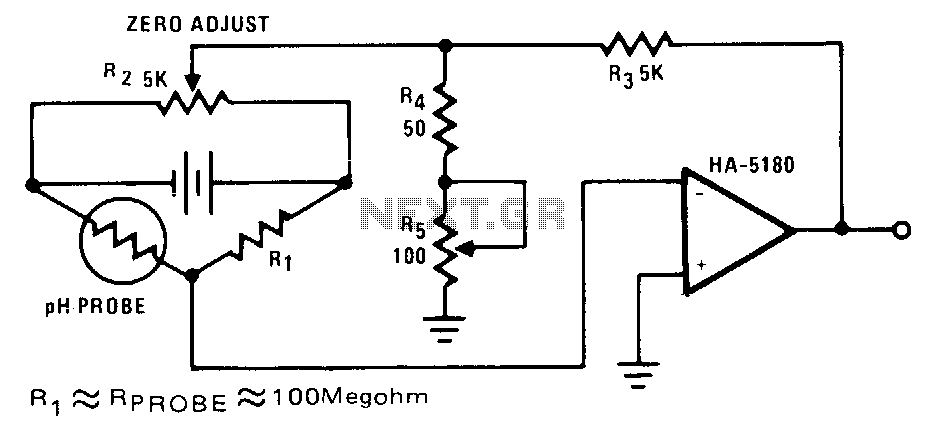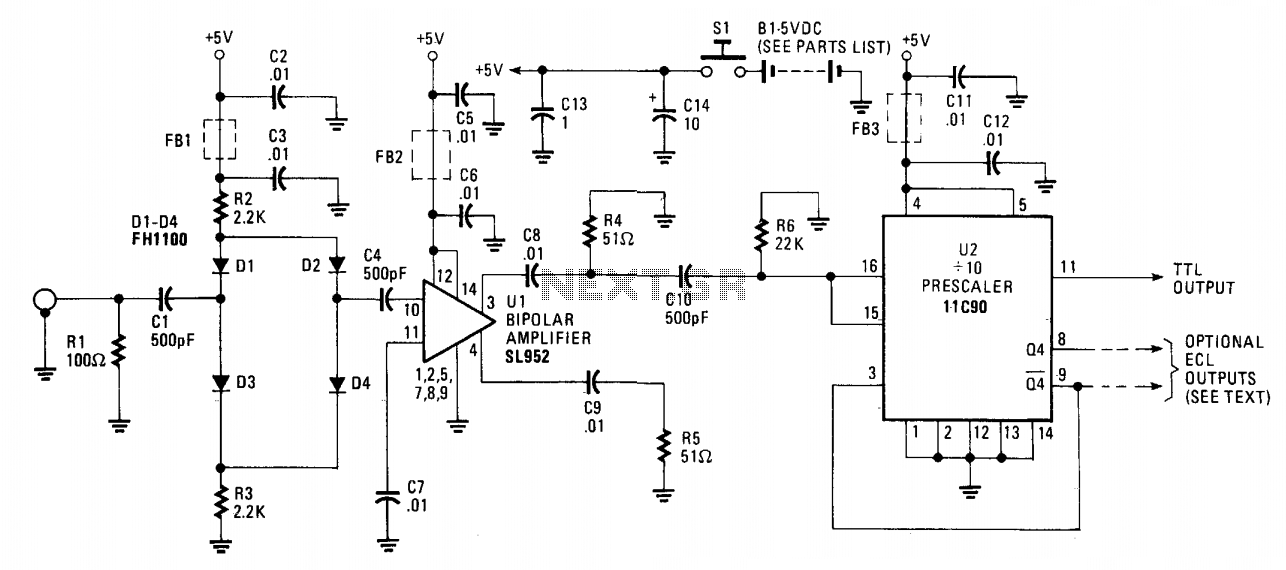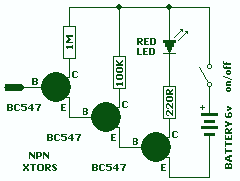
Clamp-on-current probe compensator

A clamp-on current probe, such as the Tektronix P6021, is an effective tool for displaying current waveforms on an oscilloscope. However, its low-frequency response is somewhat limited, as indicated in the accompanying table. The more sensitive range of the P6021 is 2 mA/mV, but it experiences a roll-off of 6 dB per octave below 450 Hz. A compensator is employed to counteract this low-frequency attenuation, utilizing components C3 and R4 along with PI in the feedback loop of operational amplifier N1. The operational amplifier used is a low-noise type, such as the LM725; however, it is necessary to limit the gain increase at lower frequencies to prevent amplifier noise and drift from overwhelming the signal. The values specified for C3 and R3 establish a lower frequency limit of less than 1 Hz. A test square wave of ±10 mA is applied to the current probe, allowing for the adjustment of PI to achieve minimal droop or overshoot in the output waveform. At higher frequencies, the response begins to decline starting at 100 kHz.
The clamp-on current probe configuration incorporates several key components designed to optimize performance across a range of frequencies. The operational amplifier N1 serves as the core of the signal processing unit, where its low-noise characteristics are critical for maintaining signal integrity. The feedback network, including C3 and R4, is strategically designed to enhance low-frequency response, effectively compensating for the inherent roll-off of the probe.
The choice of a low-noise operational amplifier like the LM725 is essential in applications where signal fidelity is paramount. To manage gain effectively, the circuit employs a feedback mechanism that adjusts the gain dynamically based on frequency. The values of C3 and R3 are crucial in defining the cutoff frequency, ensuring that the system remains responsive even at low frequencies while minimizing noise contributions.
The test square wave input of ±10 mA is a practical method for calibrating the probe's response. By observing the output waveform, adjustments can be made to the compensator PI to optimize the phase and amplitude characteristics, ensuring that the output remains stable without excessive droop or overshoot. This adjustment process is vital for achieving accurate readings when monitoring current waveforms.
At higher frequencies, the design anticipates a natural decline in response, commencing at 100 kHz. This characteristic is typical in many analog circuits and must be considered when selecting the probe for high-frequency applications. Overall, the integration of these components and their careful selection allows the Tektronix P6021 clamp-on current probe to function effectively across a wide frequency range, making it a valuable tool for electronic measurements.A clamp-on "current probe" such as the Tektronix P6021 is a useful means of displaying current waveforms on an oscilloscope. Unfortunately, the low-frequency response is somewhat limited, as shown in the Table. The more sensitive range on the P6021 is 2 mA/mV, but it has a roll-off of 6 dB per octave below 450 Hz.
The compensator counteracts the low-frequency attenuation, and this is achieved by means of C3 and R4 + PI in the feedback around op amp Nl. The latter is a low-noise type, such as the LM725 shown, and even so it is necessary at some point to limit the increasing gain with decreasing frequency; otherwise amplifier noise and drift will overcome the signal. The values shown for C3R3 give a lower limit below 1 Hz. A test square wave of ± 10 mA is fed to the current probe so that PI can be adjusted for minimum droop or overshoot in the output waveform.
At high frequencies, the response begins to fall off at 100 kHz. 🔗 External reference
The clamp-on current probe configuration incorporates several key components designed to optimize performance across a range of frequencies. The operational amplifier N1 serves as the core of the signal processing unit, where its low-noise characteristics are critical for maintaining signal integrity. The feedback network, including C3 and R4, is strategically designed to enhance low-frequency response, effectively compensating for the inherent roll-off of the probe.
The choice of a low-noise operational amplifier like the LM725 is essential in applications where signal fidelity is paramount. To manage gain effectively, the circuit employs a feedback mechanism that adjusts the gain dynamically based on frequency. The values of C3 and R3 are crucial in defining the cutoff frequency, ensuring that the system remains responsive even at low frequencies while minimizing noise contributions.
The test square wave input of ±10 mA is a practical method for calibrating the probe's response. By observing the output waveform, adjustments can be made to the compensator PI to optimize the phase and amplitude characteristics, ensuring that the output remains stable without excessive droop or overshoot. This adjustment process is vital for achieving accurate readings when monitoring current waveforms.
At higher frequencies, the design anticipates a natural decline in response, commencing at 100 kHz. This characteristic is typical in many analog circuits and must be considered when selecting the probe for high-frequency applications. Overall, the integration of these components and their careful selection allows the Tektronix P6021 clamp-on current probe to function effectively across a wide frequency range, making it a valuable tool for electronic measurements.A clamp-on "current probe" such as the Tektronix P6021 is a useful means of displaying current waveforms on an oscilloscope. Unfortunately, the low-frequency response is somewhat limited, as shown in the Table. The more sensitive range on the P6021 is 2 mA/mV, but it has a roll-off of 6 dB per octave below 450 Hz.
The compensator counteracts the low-frequency attenuation, and this is achieved by means of C3 and R4 + PI in the feedback around op amp Nl. The latter is a low-noise type, such as the LM725 shown, and even so it is necessary at some point to limit the increasing gain with decreasing frequency; otherwise amplifier noise and drift will overcome the signal. The values shown for C3R3 give a lower limit below 1 Hz. A test square wave of ± 10 mA is fed to the current probe so that PI can be adjusted for minimum droop or overshoot in the output waveform.
At high frequencies, the response begins to fall off at 100 kHz. 🔗 External reference
